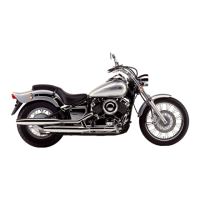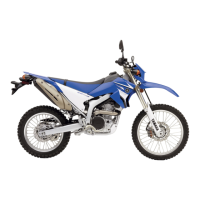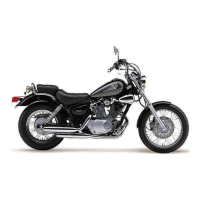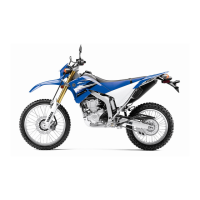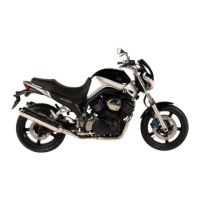Do you have a question about the Yamaha 2005 MT-01 and is the answer not in the manual?
Explains symbols like WARNING, CAUTION, and NOTE used in the manual.
Critical instruction to read the entire manual before operating the motorcycle.
Guidelines for safe operation, visibility, and operator skills.
Recommendations for helmets, eyewear, jackets, boots, and gloves.
Advice on modifications, loading, and accessories affecting stability.
Precautions regarding gasoline flammability and exhaust fume toxicity.
Identifies and explains the meaning of important labels on the vehicle.
Details on tire pressure settings for safe operation.
Diagram and labels for the left side components.
Diagram and labels for the right side components.
Identification and location of handlebar controls and dashboard instruments.
Explains the anti-theft immobilizer system and key usage.
Operation of the ignition, lighting, and steering lock.
Description of various indicator and warning lights on the dashboard.
Details on the speedometer, tachometer, odometer, and tripmeters.
Explanation of the vehicle's self-diagnosis capabilities for electrical circuits.
How to adjust the brightness of the instrument panel displays.
Operation of left handlebar controls, including lights, horn, and signals.
Operation of right handlebar controls, including engine stop, start, and hazard.
Operation of the clutch lever and shift pedal for gear changes.
Operation of the front brake lever and rear brake pedal.
Operation of the fuel tank cap and checking fuel levels.
Guidelines for preventing fire hazards and damage related to the catalytic converter.
Procedures for removing/installing the seat and adjusting front fork settings.
How to adjust spring preload and damping on the rear shock absorber.
Location and usage of luggage strap holders under the seat.
Explanation of the EXUP system and the function of the sidestand.
Details on the safety system that prevents starting under certain conditions.
Comprehensive list of checks to perform before each ride for safety.
Procedure for starting the engine, including safety system requirements.
How to shift gears, including neutral position and clutch usage.
Advice on riding techniques to improve fuel efficiency.
Guidelines for the initial 1600 km to ensure engine longevity.
Safe procedures and locations for parking the vehicle.
Location and use of the included tool kit for basic maintenance.
Schedule for regular inspections, adjustments, and lubrication tasks.
Instructions for safely removing and reinstalling the vehicle's cowling.
Procedure for checking spark plug condition, gap, and replacement.
Checking oil level, changing oil, and replacing the oil filter cartridge.
Guidance on when and how to replace the air filter element.
Checking throttle cable free play and valve clearance.
Checking tire pressure, tread depth, condition, and replacement guidelines.
Checking cast wheels for cracks, bends, or warpage.
Checking clutch lever free play and adjusting rear brake light switch.
Inspecting brake pads for wear and checking fluid levels in reservoirs.
Procedures for changing brake and clutch fluids and replacing hoses.
Checking drive chain slack, condition, and alignment.
Steps for cleaning and lubricating the drive chain.
Checking and lubricating control cables for smooth operation.
Checking throttle grip operation and lubricating the throttle cable.
Lubricating brake and shift pedal pivots.
Lubricating brake and clutch lever pivots.
Checking sidestand operation and front fork condition and operation.
Checking steering bearings for play and wheel bearings for smooth rotation.
Information on battery care and replacing blown fuses.
Step-by-step instructions for replacing headlight bulbs.
Troubleshooting if the tail/brake light does not illuminate.
Procedures for replacing turn signal and license plate light bulbs.
Instructions for replacing bulbs in the auxiliary lights.
Methods for safely supporting the motorcycle during maintenance.
General advice on troubleshooting common motorcycle issues and a diagnostic chart.
Proper methods for cleaning the motorcycle, including precautions for specific parts.
Instructions for short-term and long-term storage to protect the vehicle.
Key technical details: dimensions, weight, engine, fuel, clutch, transmission, chassis.
Details on tires, wheels, loading capacity, and tire air pressure.
Technical data for front/rear brakes and suspension system.
Information on ignition, charging, battery, lights, and fuses.
Recording key, vehicle identification, and model label information for parts ordering.
| Engine Type | Air-cooled, 4-stroke, OHV, 4-valve, V-twin |
|---|---|
| Displacement | 1, 670 cc |
| Bore x Stroke | 97.0 mm x 113.0 mm |
| Compression Ratio | 8.36:1 |
| Maximum Torque | 150.3 Nm (15.3 kg-m) @ 3, 750 rpm |
| Fuel System | Fuel Injection |
| Ignition | TCI |
| Starter | Electric |
| Transmission | 5-speed |
| Final Drive | Chain |
| Rear Suspension | Swingarm (link suspension) |
| Rear Tire | 190/50 ZR17 |
| Length | 2, 185 mm |
| Width | 800 mm |
| Height | 1, 105 mm |
| Seat Height | 825 mm |
| Wheelbase | 1, 525 mm |
| Ground Clearance | 140 mm |
| Fuel Capacity | 15 liters |
| Dry Weight | 240 kg |
| Wet Weight | 265 kg |
| Maximum Power | 66.3 kW (90 PS) @ 4, 750 rpm |
| Front Suspension | Telescopic fork |
| Front Brakes | Dual disc, 320 mm |
| Rear Brakes | Single disc, 267 mm |
| Front Tire | 120/70 ZR17 |
